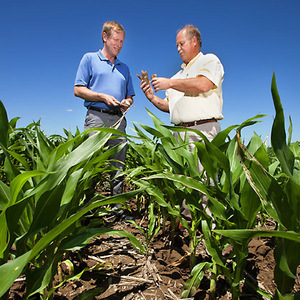Carbon sequestration not so simple in biomass crop production




USDA, Peggy Greb
February 24, 2014
BY USDA, Ann Perry
Findings at the USDA are providing information about the soil carbon dynamics that play a crucial role in lifecycle assessments of bioenergy production. These studies at the Agricultural Research Service, USDA's chief intramural scientific research agency, support the USDA priority of developing new sources of bioenergy.
Retaining carbon in the soil—called carbon sequestration—significantly affects soil fertility and greenhouse gas emissions, so it has a major impact on the long-term sustainability of bioenergy crop production. In one study, an ARS team conducted a 9-year investigation examining the impact fertilizer and harvest treatments had on soil carbon sequestration in biomass crops. Scientists contributing to the study included geneticist Ken Vogel, soil scientist Gary Varvel, agronomist Rob Mitchell, and soil scientist Ron Follett.
The team applied nitrogen fertilizer at three different rates to fields of perennial switchgrass and annual no-till maize to see how management practices affected soil carbon sequestration. Postharvest stover—corn plant residue left on the field after harvest—was not removed on half of the maize fields. On the other half of the maize fields, only half the stover was removed.
Advertisement
Advertisement
The scientists found that in the maize fields, soil carbon levels increased over time at all depths, with all nitrogen treatments, and with all postharvest stover management. They also determined that more than 50 percent of the soil carbon was found at depths between 1 foot and 5 feet below the soil surface.
More than 50 percent of the soil carbon in the switchgrass fields was also found between 1 and 5 feet below the soil surface. The average annual increase of soil carbon throughout the first 5 feet of subsoil also exceeded 0.9 tons per acre each year, which was equivalent to 3.25 tons of carbon dioxide per acre per year.
The team concluded that calculating soil carbon sequestration rates for bioenergy crops needs to factor in the effects of crop selection, soil differences, environmental conditions, and management practices. Additionally, the deep-rooted nature of these plants requires soil sampling to a depth of 5 feet to account for the increases in soil carbon.
Results from this study were published in Bioenergy Research.
Advertisement
Advertisement
Vogel recently retired from the ARS Grain, Forage, and Bioenergy Research Unit in Lincoln, Neb., where Mitchell still works. Varvel recently retired from the ARS Agroecosystem Management Research Unit in Lincoln, Neb., and Follett recently retired from the ARS Soil, Plant, and Nutrition Research Unit in Fort Collins, Colo.
Read more about this research in the February 2014 issue of Agricultural Research magazine.
Related Stories
The U.S. Department of Energy Bioenergy Technologies Office (BETO) announced up to $23 million in funding to support research and development (R&D) of domestic chemicals and fuels from biomass and waste resources.
The U.S. DOE has announced its intent to issue funding to support high-impact research and development (R&D) projects in two priority areas: sustainable propane and renewable chemicals and algal system cultivation and preprocessing.
Sens. Sherrod Brown, D-Ohio, and Pete Ricketts, R-Neb., in August introduced the Renewable Chemicals Act, a bill that aims to create a tax credit to support the production of biobased chemicals.
The Chemical Catalysis for Bioenergy Consortium, a consortium of the U.S. DOE’s Bioenergy Technologies Office, has launched an effort that aims to gather community input on the development of new biomass processing facilities.
USDA on March 8 celebrated the second annual National Biobased Products Day, a celebration to raise public awareness of biobased products, their benefits and their contributions to the U.S. economy and rural communities.
Upcoming Events










